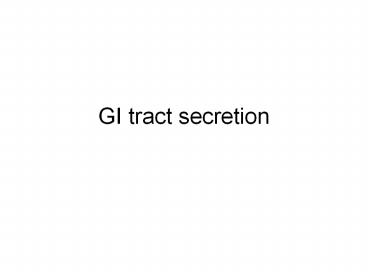GI tract secretion - PowerPoint PPT Presentation
Title:
GI tract secretion
Description:
GI tract secretion Secretory function of the GI tract Digestion Movement of food materials Linear movement Mixing Digestion Mechanical Chemical Absorption Secretion ... – PowerPoint PPT presentation
Number of Views:40
Avg rating:3.0/5.0
Title: GI tract secretion
1
GI tract secretion
2
Secretory function of the GI tract
- Digestion
- Movement of food materials
- Linear movement
- Mixing
- Digestion
- Mechanical
- Chemical
- Absorption
3
- Secretion by the GI tract
- Aids movement
- Mucus
- Provides protection
- Digestion
- Enzymes
- Bile acids
- In response to the presence of foods in the tract
4
Anatomical structures
- Single cell mucous gland
- Mucous cells/goblet cells
- Pits
- Submucosal glands
- Crypts of Lieberkun
- Tubular glands
- Oxyntic glands in stomach
- Complex gland
- Salivary
- Liver
- Pancreas
5
(No Transcript)
6
- GI tract secretion
- Epithelial stimulation
- Direct contact with food
- Enteric nerve stimulation
- Tactile
- Chemical
- Distension
- Parasympathetic stimulation
- Increased secretion in the upper GI tract
- Sympathetic stimulation
- Increase in some area
- Reduced parasympathetic-induced secretion
7
Mechanism of secretion
- Organic materials
- Exocytosis
- Water and electrolytes
- Increased ion uptake
- Inward movement of chlorine
- Movement of sodium ion
- Osmosis
- Release of fluids by opening of channels
- Hydrostatic pressure
8
Mucus
- Chemical composition
- Different among different regions within the
tract - Adhesiveness
- Ability to coat the tract
- Low resistance against movement
- High resistance to digestion
- Buffering
9
Saliva
10
- Composition
- Serous
- Amylase
- Mucous
- Mucin
- Ions
- Bicarbonate
- Potassium
- Low sodium and chloride ion concentrations
11
Salivary Glands
Type of of total Gland
saliva Secreted Parotid
Serous Submandibular Mucous /
Serous Sublingual Mucous
10 / Serous Buccal Mucous
lt1
90
12
(No Transcript)
13
- Saliva and oral hygiene
- Removal of pathogens and food particles
- Bactericide activity
- Immunity
14
- Nervous regulation of secretion
- Parasympathetic nervous system
- Tactile and taste stimulation of salivatory
nuclei - Higher CNS
- Regulation of salivatory nuclei
- Reflexes
- Lower GI tract
15
Esophageal secretion
- Mucus
- Lubrication for swallowing
- Simple mucous cells
- Protection of the lower esophagus
- Compound glands located in the lower portion
16
Gastric secretion
- Types of secretion
- Mucous cells
- Mucus
- Oxyntic glands
- Hydrochloric acid
- Pepsinogen
- Intrinsic factor
- Pyloric glands
- Mucus
- gastrin
17
Phase of secretion
20
70
18
- Oxyntic glands
- Cells
- Mucous neck cells
- Parietal cells
- HCL
- Intrinsic factor
- Peptic/chief cells
- Pepsinigen
19
- HCL
- Formed at the villus-like structures inside of
canaliculi
20
(No Transcript)
21
- Pepsinogen
- Activated by HCL
- Secretion
- Acetylcholine
- Stomach acid
- Inhibition of gastric secretion
- Reverse enterogastric reflex
- Presence of chemicals within the intestine
22
Pancreatic secretion
- Digestive enzymes
- Pancreatic acini
- Sodium bicarbonate
- Ducts
23
- Secretion
- Presence of chyme
- Determines the composition of pancreatic
secretion - Stimulated by
- Acetylcholine
- Acinar secretion
- Cholecystokinin
- Acinar secretion
- Secretin
- Ductal secretion
24
- Pancreatic enzymes
- Carbohydrate digestion
- Amylase
- Protein digestion
- Trypsin
- Chymotrypsin
- Carboxylpolypeptidase
- Lipid digestion
- Lipase
- Cholesterol esterase
- Phospholipase
25
Phase of secretion
20 pancreatic secretion
5-10 Pancreatic secretion
Majority of secretion (secretin)
26
Bile secretion
- Secretion
- Hepatocytes
- Initial secretion
- Drained into ducts
- Secretion to the SI
- Accumulation in the gallbladder
- Gallbladder
- Increased concentrations of bile salts
- Removal of sodium ions
- Absorption of chloride ions
- Osmosis of water
27
- Emptying
- In response to fats in the chyme
- Secretion of cholecystokinin
- Contraction of gallbladder wall and relaxation of
the sphincter of Oddi
28
- Function
- Fat digestion and absorption
- Emulsification
- Detergent function
- Formation of micelles
- Bile is amphipathic in nature (cholesterol plus
salt) - Hydrophobic core/pocket for lipids
- Bile salts
- Recycled
- Enterohepatic circulation
29
Secretion of the small intestine
- Compound mucous cells
- Brunners gland
- Site where pacreatic secretion and bile enter the
intestine - Alkaline mucus for protection
- Added effects with pacreatic bicarbonate ions and
bile - Secretion
- Tactile stimulation
- Irritation
- Vagus stimulation
- Secretin
30
- Crypts of Liererkuhn
- Goblet cells
- Mucus
- Enterocytes
- Water and electrolytes
- Secretion
- Rapidly reasborbed by the villi
31
- Secretion of the watery mucus
- Active secretion of chloride ions
- Active secretion of bicarbonate ions
- Passive/drag movement of sodium ions
- Results of these
- Osmosis
32
- Digestive enzymes
- Peptidases
- Enzymes for disaccharide digestion
- Sucrase
- Maltase
- Lactase
- Isomaltase
- Lipase
- Secretion
- Regulated by the local stimuli
- Enteric nervous reflex
33
Secretion by the large intestine
- No enzyme secretion
- Only mucus
- Bicarbonate ions
- Non-mucous cells
- Secretion
- Tactile stimulation
- Local nervous reflex to the cryts of Leiberkuhn
- Protection of the large intestine
- Acids from bacterial metabolism
- Adhesive for feces formation































